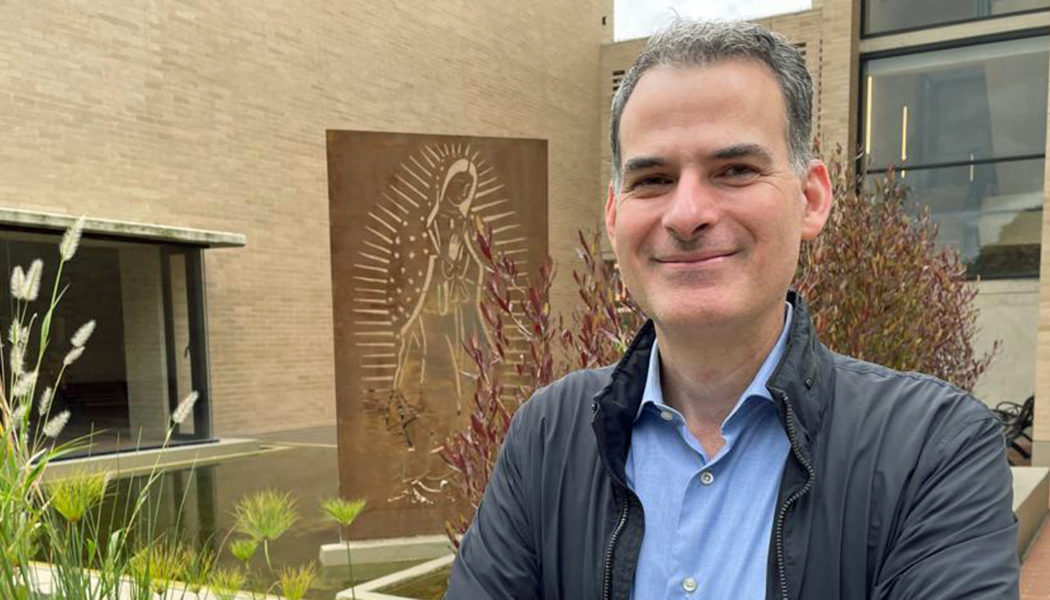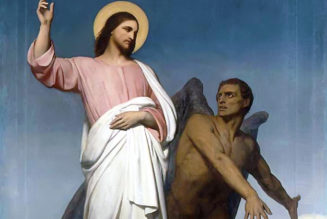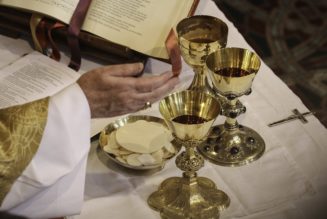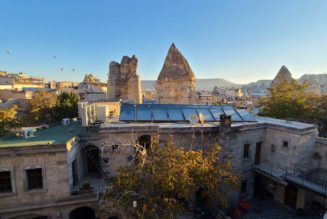Rafael Luciani is a professor of theology at the Andrés Bello Catholic University in Caracas, the capital of his home country Venezuela. However, Luciani also advises the Latin American Bishops’ Council CELAM and is an advisor to the Theological Commission of the Synod on Synodality. In an interview with katholisch.de, Luciani explains his understanding of synodality. The theologian considers the image of the Church as the people of God to be central in view of the upcoming changes in the Church.
Question: Mr Luciani, the Instrumentum laboris for the second session of the Synod in October has now been published. This makes it clear what the members of the Church Assembly will be dealing with. Does this also mean that the topics that Pope Francis decided in March would be dealt with by expert commissions are finally off the table?
Luciani: There was and still is some uncertainty in this context. If we look at the topics of the ten study groups, such as “Listening to the cry of the poor”, these are issues that touch on several areas. They appear in the feedback from the bishops’ conferences, which has been incorporated into the Instrumentum laboris, but are also being addressed by the relevant study groups. There are different positions on many of these topics, for example the diaconate for women, which were also reflected in the synthesis report of the last session last October. In my opinion, however, the decisive question here is how the teachings of the Second Vatican Council were received on the various continents. Because that makes the discussion about it easier or more difficult.
Question: Could you explain this in more detail?
Luciani: One example: In Latin America, the concepts of the people of God and the option for the poor facilitated the reception of the Council. But this was not the case on all continents. When the Pope has now set up a study group on the topic of the poor, he is not only doing so in relation to Latin America, but also to the frequent lack of reception of the option for the poor in the universal Church. The situation is similar with regard to the diaconate of women. If an ecclesiology of the people of God has not been received in all local churches worldwide, it is very difficult to open the horizon to the ordained ministries and not just understand them in isolation as individual topics. There must be a common vision of the Church of ministries, charisms, services and other forms of activity in the community of believers. That is why it is not good here to speak of individual topics, but of a reception of the Second Vatican Council that facilitates or complicates discussion and consensus on certain points. That was what the Pope wanted when he set up the study groups. He did not want to remove the ten topics from the synod’s agenda, but to hand them over to experts who will continue to work on them after the synod. Furthermore, it is unfortunately the case that not all members of the synod have the necessary theological knowledge to deal with such important topics for the Church in just three weeks of discussion.
Question: The Pope’s decision to create study groups on obviously controversial topics has sometimes been heavily criticised. Many see it as an attempt to remove “hot potatoes” from the synod’s agenda. So you don’t see it that way?
Luciani: The context of each local church since the Second Vatican Council is different, and the reception of the Council’s resolutions varies greatly. In Germany, Austria and Switzerland in particular, there were synods of the respective local churches, in Italy and Spain there was a separate way of reflecting on the ministry and in Latin America the continental bishops’ council CELAM was founded. But these are all local or regional exceptions to the whole world church. Anyone who looks to Africa, Asia or North America will recognise that the reception of the Council did not take place by means of the ecclesiology of the image of the people of God. It can therefore be said that the Synod on Synodality that is now taking place has advanced the whole world church.

The Venezuelan theologian Rafael Luciani is a professor at the Andrés Bello Catholic University in Caracas (Venezuela). He is also an associate professor at Boston College (USA) and advisor to the General Secretariat of the Synod in the Vatican and the Latin American Bishops’ Council CELAM. Luciani’s research focuses on Christology, ecclesiology, Latin American theologies and the Second Vatican Council.
Question: So it is essentially about the implementation of the Second Vatican Council?
Luciani: We are currently in an ecclesiological transition: we are moving from a universalist understanding of the Church that was solidified in the 1980s and 1990s during the pontificate of John Paul II. Benedict XVI has continued this image of the Church. The consequence was that the understanding of the church as a local church suffered. The Pope and the Vatican, on the other hand, were overemphasised. Francis has brought back the theology of the local churches and is now deepening it. But all this is happening in a context in which the vast majority of local churches do not understand exactly what this means. For example, what authority means in terms of ministries, in terms of doctrine, also with regard to the local churches and their bishops’ conferences. That is why we are currently in a situation in which the decisions of the synod cannot be understood, received and implemented in the same way in the different local churches. When the ecclesiological transition is complete, the local churches will have their own authority.
Question: In what way will you have your own authority?
Luciani: One example is that of the bishops’ conferences: In his 2013 letter “Evangelii gaudium”, Francis was the first pope ever to quote bishops’ conferences, thereby honouring them. This was an innovation that recognises that a bishops’ conference, i.e. an institution on a level between bishops and the Pope, can have a magisterial effect. The Pope cited this in his magisterium. Many of the local churches and local bishops’ conferences have not yet understood the change that has taken place here.
Question: Conversely, this means that we have many local churches in the universal church that are moving forward at very different speeds.
Luciani: If we see the global church in transition to a church of local churches, there is quite naturally a diversity of forms and speeds. In Latin America, the aforementioned Council of Bishops CELAM has been in existence since 1955. This body is a joint organisation of various local churches. In Europe there are similar institutions, COMECE and CCEE, but the European bishops have never worked together as closely as in Latin America. The current synod is important because it has brought together the individual local churches on many continents for the first time in a real communion. This contributes to a greater maturity of the local churches and, in the long term, will lead them to realise what authority they have in terms of doctrine and ministries. The synod also draws attention to certain local churches, such as those in the German-speaking countries, where major developments have been made since the Council. At this point in time, it is the churches in these countries and in Latin America that are pushing forward.
Question: The Church in Germany is often accused of taking a special path with the Synodal Path. Do you share this opinion?
Luciani: The Synodal Path in Germany is very important, especially the form that was chosen to implement it. The Synodal Path cannot be separated from the development of the Church in Germany after the Second Vatican Council. But not in all parts of the world is the Church understood in the same way as in Germany, so explanatory work needs to be done. For example, a comprehensive translation of the resolutions of the Synodal Path into many languages is needed. Another example of this is CELAM: this council not only stands for the communion of local churches, but has also set up an ecclesial assembly in which lay people, priests, religious and bishops meet to seek decisions together. There, the episcopal principle is not above the synodal principle, but the episcopal office is in the centre of the synodality of the entire people of God. This was unknown at the level of the universal church until the worldwide synodal process was initiated by Francis. In Africa or the Middle East, the concept of the ecclesial assembly, in which the voice of the laity is equal to that of the bishops, is unknown. That is why the reception of this concept is difficult there. Incidentally, the same applies to North America: in the USA, the church is basically dysfunctional and unfortunately there does not seem to be any real community among the bishops there. If the German Synodal Path and the concept of the ecclesial assembly from Latin America do not enter into dialogue with the whole Church, they will remain isolated experiences.

“The local churches in Latin America speak with one voice, but in Europe the Church has different voices in different countries – from which the Church in Germany stands out in particular. This can be a difficulty,” says Venezuelan theologian and synod advisor Rafael Luciani about the Synodal Way.
Question: In the past, there has been repeated criticism of the Synodal Path from Rome, but not of the church assemblies in Latin America, such as the Amazon Church Conference. Why is that?
Luciani: In Latin America, cooperation between the local churches began back in the 1950s, i.e. before the Second Vatican Council. There is also the CLAR, the Latin American Council of Religious, which works together on a continental level and connects the individual local churches. Francis comes from Argentina and is a Jesuit, so he understands this concept very well and lives it. The local churches in Latin America speak with one voice, but in Europe the Church has different voices in different countries – of which the Church in Germany stands out in particular. This can be a difficulty. Especially for those who are not familiar with the history of the German church and who are not familiar with the Würzburg Synod, for example.
Question: What will a synodal church look like?
Luciani: The future will be very complex and will progress slowly. Because a reform process like this will not be completed in one generation. After the Council of Trent, it took 100 years for its resolutions to be implemented and for the institutions it created, such as the seminary and the parish, to be established throughout the Church. We are only six decades on from Vatican II and are in the midst of the ecclesiological transition described above, which only helps us to understand that this Council has not been fully received. If we want synodality in the Church, but the ecclesiology of the Council, the People of God, has not been accepted, there will be no synodal Church. And if we look at the universal Church, it is clear that in the majority of local churches there has been no reception of the Church as the people of God.
Question: In which local churches, for example?
Luciani: The Church in Africa, for example, says that the image of the Church as the people of God or the tent of God among the people does not represent their image of the Church. They prefer the image of the family. In Australia and Oceania, which are surrounded by the sea, the Church has also rejected this image. The great significance of Francis’ pontificate is that it has heralded a change towards a world church that sees itself as the people of God. But the Pope has a double task to fulfil: he must promote the change in the understanding of the Church and also ensure that this innovation reaches all local churches. If, at the end of the synod, we have a document that makes this ecclesiological leap and establishes the understanding of the Church as the people of God, there will be further developments in the areas of ministries and doctrine.
Question: Are these reforms also taking so long because the term synodality is new to the Catholic Church and everyone understands it to mean what they want it to mean?
Luciani: When the Pope says that the Church is constitutively synodal, this is not received in the same way in all local churches. The Church is synodal in its being and doing. Synodality is therefore not a method, but rather defines the Church. But if many local churches are not clear about what the church actually is, they continue to see synodality as a method. This is a great difficulty for the universal church. In addition, some local churches wonder how synodality affects decision-making in the church. How bishops and laity make decisions together was also a key issue when the Amazon Church Conference was set up. But this only applies to very few local churches. That is why it is good that the synod will not end in October. When Francis reformed the Synod of Bishops, he defined three major phases: the preparatory phase, the implementation phase – which we are now in – and the final phase, the reception. This is something new. That is why the final document of the synod cannot be described as a conclusion. This is where the ten study groups set up by Francis have an important task. They will deal with their topics, deepen them and find a consensus on their content. The individual local churches will then have to implement the proposals. Ultimately, it is about a change of mentality: it should not be a question of following everything that comes out of Rome. Francis has spoken of the decentralisation of the Church.
by Roland Müller


![The media are scapegoating Catholics for the Club Q shooting in Colorado Springs [WSJ paywall]…](https://salvationprosperity.net/wp-content/uploads/2022/12/the-media-are-scapegoating-catholics-for-the-club-q-shooting-in-colorado-springs-wsj-paywall-327x219.jpg)






